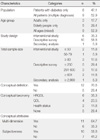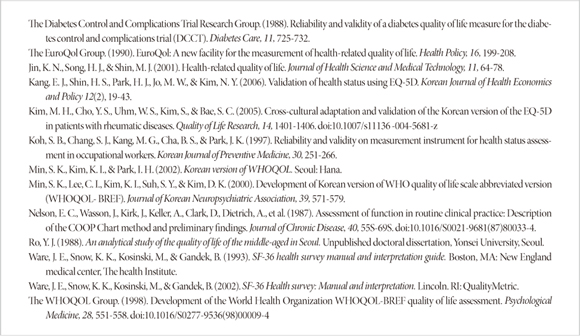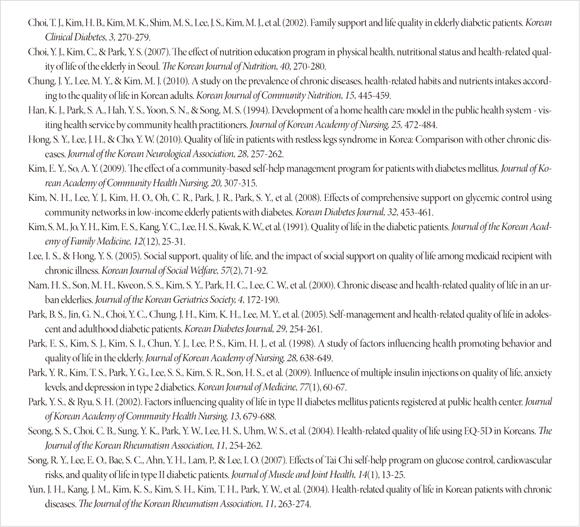2. Boyer JG, Earp JA. The development of an instrument for assessing the quality of life of people with diabetes: Diabetes-39. Medical Care. 1997. 35:440–453. doi:
10.1097/00005650-199705000-00003.
3. Brazier J, Jones N, Kind P. Testing the validity of the Euroqol and comparing it with the SF-36 health survey questionnaire. Quality of Life Research. 1993. 2:169–180. doi:
10.1007/BF00435221.
4. Brooks R, Rabin R, de Charro F. The measurement and validation of health status using EQ-5D: A European perspective. 2003. Dordrecht: Kleuer Academic Publishers.
5. El Achhab Y, Nejjari C, Chikri M, Lyoussi B. Disease-specific health-related quality of life instruments among adults diabetic: A systematic review. Diabetes Research and Clinical Practice. 2008. 80:171–184.
6. Fayers PM, Machin D. Quality of life: The assessment, analysis and interpretation of patient-related outcomes. 2007. 2nd ed. West Sussex: John Wiley & Sons.
7. Fryback DG. Advancing social science theory - the importance of common metrics: Measuring health-related quality of life. Workshop conducted at the meeting of The National Academies. 2010. 02. Washington, DC: Division of Behavioral and Social Sciences and Education.
8. Garratt AM, Ruta DA, Abdalla MI, Russell IT. SF-36 health survey questionnaire: II. Responsiveness to changes in health status in four common clinical conditions. Quality in Health Care. 1994. 3:186–192.
9. Gill TM, Feinstein AR. A critical appraisal of the quality of quality-of-life measurements. JAMA. 1994. 272:619–626. doi:
10.1001/jama.272.8.619.
10. Guyatt GH, Feeny DH, Patrick DL. Measuring health-related quality of life. Annals of Internal Medicine. 1993. 118:622–629.
11. Hammond GS, Aoki TT. Measurement of health status in diabetic patients. Diabetes Care. 1992. 15:469–477. doi:
10.2337/diacare.15.4.469.
12. Hays RD, Anderson R, Revicki D. Psychometric considerations in evaluating health-related quality of life measures. Quality of Life Research. 1993. 2:441–449. doi:
10.1007/BF00422218.
13. Jacobson A, Barofsky I, Cleary P, Rand L. Reliability and validity of a diabetes quality-of-life measure for the diabetes control and complications trial (DCCT). Diabetes Care. 1988. 11:725–732.
14. Kim MH, Cho YS, Uhm WS, Kim S, Bae SC. Cross-cultural adaptation and validation of the Korean version of the EQ-5D in patients with rheumatic diseases. Quality of Life Research. 2005. 14:1401–1406. doi:
10.1007/s11136-004-5681-z.
15. Korea Centers for Disease Control and Prevention. 2007 National health survey: The 4th Korea national health and nutrition examination survey. 2008. Seoul: Author.
16. Lee EH. Development and psychometric evaluation of a quality of life scale for Korean patients with cancer(C-QoL). Journal of Korean Academy of Nursing. 2007. 37:324–333.
17. Lohr KN, Aaronson NK, Alonso J, Burnam MA, Patrick DL, Perrin EB, et al. Evaluating quality-of-life and health status instruments: Development of scientific review criteria. Clinical Therapeutics. 1996. 18:979–992. doi:
10.1016/S0149-2918(96)80054-3.
18. Mesbah M, Cole BF, Lee MT. Statistical methods for quality of life studies. 2002. Boston: Kluwer Academic Publishers.
19. Patrick DL, Chiang YP. Measurement of health outcomes in treatment effectiveness evaluations: Conceptual and methodological challenges. Medical Care. 2000. 38:9 suppl. II14–II25. doi:
10.1016/S0149-2918(96)80054-3.
21. Scientific Advisory Committee. Instrument review criteria. Medical Outcomes Trust Bulletin. 1995. 3:I–IV.
22. Smith KW, Avis NE, Assmann SF. Distinguishing between quality of life and health status in quality of life research: A meta-analysis. Quality of Life Research. 1999. 8:447–459. doi:
10.1023/A:1008928518577.
23. Snoek FJ. Quality of life: A closer look at measuring patients' well-being. Diabetes Spectrum. 2000. 13:24–28.
24. Ware JE, Sherbourne CD. The MOS 36-item short-form health survey (SF-36). I. Conceptual framework and item selection. Medical Care. 1992. 30:473–483.
25. Watkins K, Connell CM. Measurement of health related QOL in diabetes mellitus. Pharmacoeconomics. 2004. 22:1109–1126. doi:
10.2165/00019053-200422170-00002.







 PDF
PDF ePub
ePub Citation
Citation Print
Print





 XML Download
XML Download